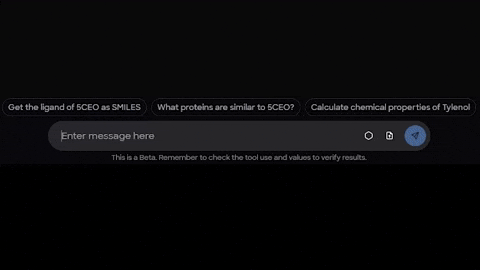MARA is here to aid in analyzing assay data outputs
Overall Workflow
- Bring in assay data and perform 4 parameter logistical analysis
- Clean-up data outputs
- Calculate pIC50
- Add SMILES to table
- Merge datasets
- Calculate Murcko Scaffolds to better categorize molecules
- Graph molecules by pIC50 values to determine trends
- Perform Principle Component Analysis (PCA) on the dataset
- Graph molecules by Principle Components and highlight scaffold clusters
- Perform an unbiased Cluster Analysis
- Graph molecules by Principle Components highlighting new clusters
- Generate and interrogate dose-response curve graphs of outlier molecules
For this example, we will use mock data that has been prepared by normalizing dosages in the nM range
Upload and analyze your assay data for IC50
First, normalize your assay data and upload it to MARA by attaching the files. Then, prompt MARA to assess for a logarithmic regression to produce an IC50 and report the statistical significance. “Calculate the IC50s from these datasets, my key column is Molecule” is a simple prompt as it does indicate the key column to group the data properly.

Clean up, merge data sets, and add structure-based properties
Next, we want to analyze all the data together, but merging all of the data from the report isn’t directly helpful. We’ll also take the IC50 and improve the scaling by taking the pIC50. Running this over all three CSVs is easy with a prompt like “Calculate the -Log10 of the IC50 (nM) column for each of the results of the last run.”

Next we need to merge the CSV files into a single file to make it easier to analyze the dataset together. Asking to “Merge these three CSVs the key column is Molecule” is a good approach.

Adding in the SMILES from a previous dataset matched to each Molecule allows us to include structure-based analysis with our assay data.

Such as Murcko scaffolds…

…and chemical property data.

Graphing pIC50 pairs and examining for clusters
I want to see if trends in assay activity create clusters along the lines of my scaffolds or not. So, I’ll simply graph the three pIC50 values (pIC50_x, pIC50_y, and pIC50) against each other with a single prompt “Graph pIC50_x, pIC50_y, and pIC50 against each other colored by Murcko_No in 2D plots”.

Analyzing, graphing principal components, and performing cluster analysis
We see some clustering, but let’s use principal component and cluster analysis to find more robust clusters. We need to perform principal component analysis first so we can perform cluster analysis on the condensed data. We will ask MARA to “Please perform PCA on the most recently created CSV” and MARA will limit the analysis to the numerical data. I want to see how the Murcko Scaffolds map to the principal component graphs, as well.

Next we can graph the principal components against each other with scaffold coloring.

We then follow with cluster analysis focused on the principal components “Perform cluster analysis on the most recently created CSV using only PC1, PC2, and PC3”.

Then we can graph to examine this information “Graph PC1, PC2, and PC3 against each other colored by Label in 2D plots”.

Examining dose-response curves of a relevant subset
Last thing we’ll do is study the outliers from this analysis that show IC50’s that are sub-micromolar using this query in the table data engine “Give me a list of Molecule values that have a Label of -1 and a pIC50, pIC50_x, and pIC50_y greater than 6”.

Then, we’ll ask for the graphs of the molecules that are given to us.

MARA streamlines the process of analyzing assay data by integrating advanced computational tools with an intuitive workflow. From data normalization to cluster analysis and dose-response curve interrogation, MARA empowers scientists to extract meaningful insights with ease. By combining structural information with assay outputs, MARA enables a deeper understanding of molecular behavior, fostering more informed decision-making in drug discovery and research. Embrace MARA to accelerate your scientific breakthroughs and unlock the full potential of your data.
Written by Jonathon Gast, PhD, Joe Laureanti, PhD, and Edgardo Leija.
If you'd like to talk with us about any of your data challenges and learn more about how MARA can help, feel free to tell us more about your project here.